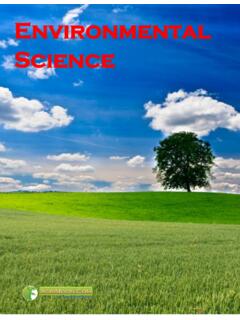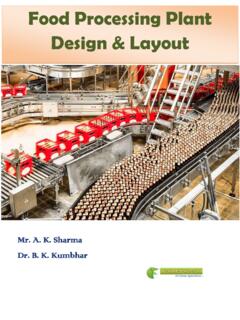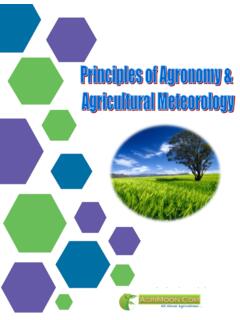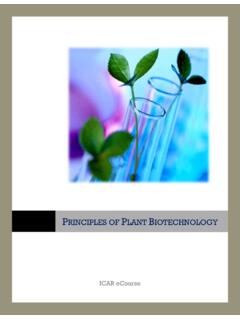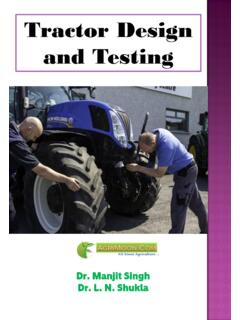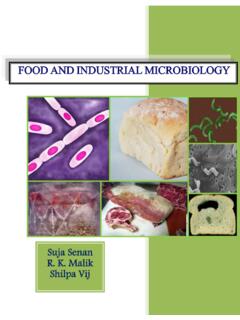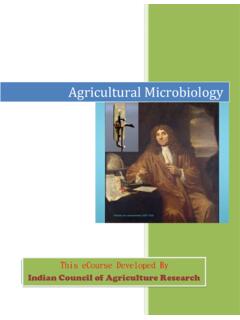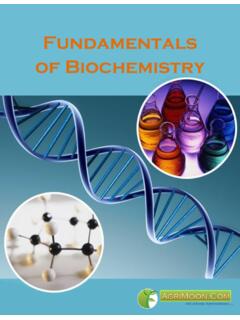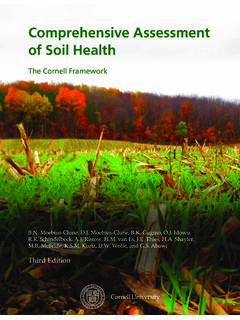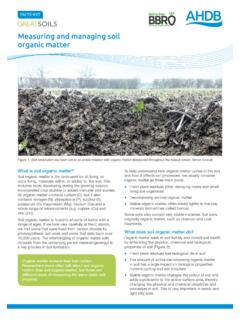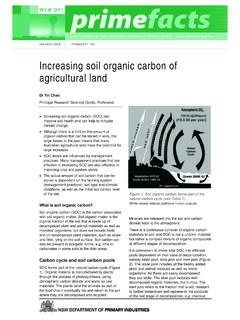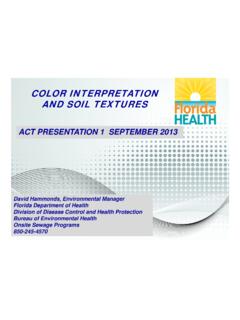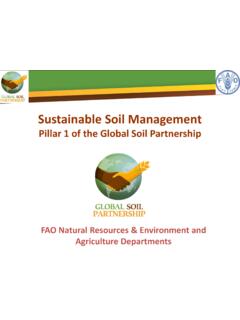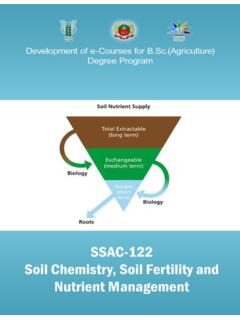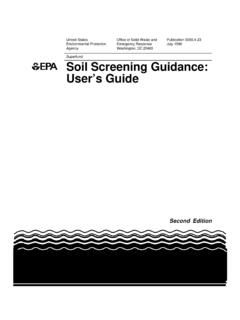Transcription of Introduction to Soil Science ICAR e-Course - AgriMoon
1 Introduction to soil Science ICAR e-Course For (Agriculture) Index SSAC 121 - Introduction TO soil Science SN Chapter Page No 1 soil Pedological and edaphological concepts 1-4 2 Origin of the earth Earth s crust Composition 5-15 3 Rocks and minerals 16-36 4 Weathering 37-47 5 soil formation factors and processes Components of soils 48-61 6 soil profile 62-64 7 soil physical properties soil texture Textural classes Particle size analysis 65-72 8 soil structure C lassification 73-81 9 soil aggregates significance soil consistency soil crusting Bulk density and particle density of soils & porosity - their significance and
2 Manipulation 82-89 10 soil compaction soil Colour soil water 90-98 11 Retention and potentials soil moisture constants 99-106 12 Movement of soil water Infiltration, percolation, permeability Drainage Methods of determination of soil moisture 107-113 13 Thermal properties of soils soil temperature soil air Gaseous exchange Influence of soil temperature and air on plant growth 114-122 14 soil colloids Properties, nature, types and significance 123-129 15 Layer silicate clays their genesis and sources of charges 130-145 16 Adsorption of ions Ion exchange CEC& AEC Factors influencing ion exchange -Significance.
3 146-155 17 soil organic matter Composition Decomposability 156-164 18 Humus Fractionation of organic matter 165-168 19 Carbon cycle C : N ratio. soil biology Biomass soil organisms Their beneficial and harmful roles. 169-189 01. soil Pedological and Edaphological concepts soil Science is the study of soil as a natural resource on the surface of the earth including soil formation, classification and mapping; physical, chemical, biological, and fertility properties of soils; and these properties in relation to the use and management of soils. Sometimes terms which refer to branches of soil Science , such as pedology (formation, chemistry, morphology and classification of soil ) and edaphology (influence of soil on organisms, especially plants), are used as if synonymous with soil Science .
4 The diversity of names associated with this discipline is related to the various associations concerned. Indeed, engineers, agronomists, chemists, geologists, physical geographers, ecologists, biologists, microbiologists, sylviculturists, sanitarians, archaeologists, and specialists in regional planning, all contribute to further knowledge of soils and the advancement of the soil sciences. soil scientists have raised concerns about how to preserve soil and arable land in a world with a growing population, possible future water crisis, increasing per capita food consumption, and land degradation.
5 soil occupies the pedosphere, one of Earth's spheres that the geosciences use to organize the Earth conceptually. This is the conceptual perspective of pedology and edaphology, the two main branches of soil Science . Pedology is the study of soil in its natural setting. Edaphology is the study of soil in relation to soil -dependent uses. Both branches apply a combination of soil physics, soil chemistry, and soil biology. Due to the numerous interactions between the biosphere, atmosphere andhydrosphere that are hosted within the pedosphere, more integrated, less soil -centric concepts are also valuable.
6 Many concepts essential to understanding soil come from individuals not identifiable strictly as soil scientists. This highlights theinterdisciplinary nature of soil concepts. soil Science The Science dealing with soil as a natural resource on the surface of the earth, including Pedology ( soil genesis, classification and mapping), physical, chemical, biological and fertility properties of soil and these properties in relation to their management for crop production. soil Science has six well defined and developed disciplines soil fertility : Nutrient supplying properties of soil Introduction to soil Science soil chemistry : Chemical constituents, chemical properties and the chemical reactions soil physics : Involves the study of physical properties soil microbiology : Deals with micro organisms, its population, classification, its role in transformations soil conservation : Dealing with protection of soil against physical loss by erosion or against chemical deterioration excessive loss of nutrients either natural or artificial means.
7 soil Pedology : Dealing with the genesis, survey and classification Views on soil ( Science ) The term soil was derived from the Latin Word SOLUM Means FLOOR For a Layman soil is dirt or debris For an Agriculturist soil is a habitat for plant growth (to grow crops) For a Mining Engineer soil is a debris covering the Rocks For a Civil Engineer soil is a material on which road bed or house bed is formed For a Home Owner soil is a mellow or loamy or hard material Definitions Generally soil refers to the loose surface of the earth as identified from the original rocks and minerals from which it is derived through weathering process.
8 Whitney (1892): soil is a nutrient bin which supplies all the nutrients required for plant growth Hilgard (1892): soil is more or less a loose and friable material in which plants, by means of their roots, find a foothold for nourishment as well as for other conditions of growth Dokuchaiev (1900): Russian scientist - Father of soil Science - soil is a natural body composed of mineral and organic constituents, having a definite genesis and a distinct nature of its own. Joffe (1936): soil is a natural body of mineral and organic constituents differentiated into horizons - usually unconsolidated - of variable depth which differs among themselves as well as from the underlying parent material in morphology, physical makeup, chemical properties and composition and biological characteristics.
9 Jenny (1941): soil is a naturally occurring body that has been formed due to combined influence of climate and living organisms acting on parent material as conditioned by relief over a period of time. Ruffin and Simonson (1968): soil is a mixture of Earth s uppermost mantle of weathered rock and organic matter Introduction to soil Science and Brady (1969 ): soil is a dynamic natural body on the surface of the earth in which plants grow, composed of mineral and organic materials and living forms soil Science Society of America (1970) (i) soil is the unconsolidated mineral matter on the surface of the earth that has been subjected to and influenced by genetic and environmental factors of parent material, climate (including moisture and temperature effects)
10 , macro and microorganisms and topography, all affecting over a period of time and producing a product, that is soil that differs from the material from which it is derived in many, physical, chemical, biological and morphological properties and characteristics. (ii) The unconsolidated mineral material on the immediate surface of the earth that serves as a natural medium for the growth of land plants. Dr. Blum Soils not only serve for agriculture and forestry, but also for filtering, buffering and transformation activities between the atmosphere and the ground water, protecting the food chain and drinking water against pollution and biodiversity As soil provides nutrients, water, air and anchorage and supports life on Earth, it can be called as Soul Of Infinite Life ( soil ) List of International soil Scientists 1.
